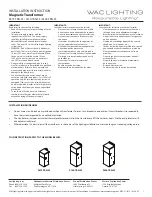Page 8 of 19
pacificon_assy_041621.pdf
Initial Power up:
Before you apply power to the circuits, spend a few moments to inspect your
work. Soldering issues are the most common cause of a kit not working first and
every time.
Grounds take a little more heat than connections to tracks, so look at these
carefully to make sure the solder didn't just stick to the lead.
Use an ohmmeter to check for continuity through the toroids. Not fully
stripping the magnet wire and making a good connection is a common
problem.
If T1 is installed correctly there will be continuity between all four pads.
Before any of the IC's are installed into their sockets, it's a good idea to
check to see if the voltage regulators are working correctly.
Apply power to the board.
Check for 9V – Pins 8 (+) and 4 (-) of the U3 socket is a good place to
check.
Check for 5V – Pins 7 (+) and 8 (-) of U5 is a good place to check.
Good to Go?
Insert the MEGA328P processor into the 28 pin socket. Make sure it goes in the
correct way, although it will not be damaged if powered up in wrong way. (this is
not true of the other ICs)
Plug in your supply (12 to 14V) and turn it on.
If all is well, The display will read [ bn40P].
If it didn’t, did you jumper the “On-Off” pads?
The data for the selected band is now loaded, the default operating
frequency displayed and the board is now ready for additional testing.
Remove power.
You can now install the rest of the ICs.
▪
[] U1 – SA602
▪
[] U3 – LM358
▪
[] U6 - LM386
Connect up your antenna
Plug in the speaker/mic
Turn power back on
Turn the volume up and you should hear band noise. Tune around and find
some stations.
So far so good? If not jump to the trouble shooting guide, p16.
Содержание Pacificon KD1JV
Страница 19: ...Page 19 of 19 pacificon_assy_041621 pdf...


















